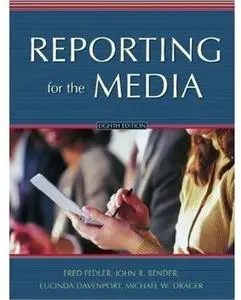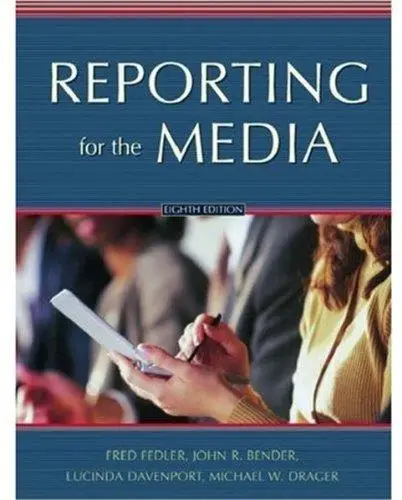Reporting for the Media By Fred Fedler, John R. Bender, Lucinda Davenport, Michael W. Drager
2005 | 700 Pages | ISBN: 0195169999 | PDF | 11 MB
2005 | 700 Pages | ISBN: 0195169999 | PDF | 11 MB
I had to get this book for my Journalism class (Hello Ms. Noguera!) and I found it an interesting textbook that had both good and bad points. On the plus side it is pretty thorough as far as teaching the basics of how to format your writings, and how to use basic grammar and spelling. I've had English writing courses that were less thorough than some of the materials that are printed here. The early to mid chapters are all pretty good in giving you the details how to write so that readers will continue to read your news stories, and so editors will continue to buy them. This book also has an extreme amount of writing exercises that will allow you to practice what you have just read about in each chapter. Just in case the authors constant detailing of how to write properly for publication starts to wear you down, each chapter is peppered with plenty of examples, some of which are full length short articles, to use to compare to your own writing when you do the assignments. Many of these examples are interesting in and of themselves. On the opposite side of things I found the book to be too fragile. For some reason the book is constructed so that each page is serrated so that it can be torn out. Why? I can almost see having the assignment sheets as tearaways, but why the rest of the text pages? Even the index and appendixes are serrated! If you use the book as it should be used, the pages will fall out just through the regular use of the book. But considering that most of the writing assignments are extensive writing projects, you can't even use the assignment sheets to write on anyway if you were to tear them out. Good textbooks should last a long time and be in constant use. While the book gives the student plenty of assignments to do, some of the later chapters refuse to give us examples of what the student's writings should look like when they are done. A good example of this is the public affairs and crime chapter (Chapter 16), which gives us plenty of detail on HOW to do the story, but doesn't give us a single example WHAT the story will look like after you're done. Another thing that annoys is having plenty of writing assignments without some form of answer keys or pages. A few assignments are given answers, but these are VERY select. No answer keys for most of the book's assignment ultimately makes doing these exercises on your own a useless pursuit, as you will not know if you're doing one of them the correct way. Since this book is meant to be used only in a classroom setting, these book's assignments can only be written, and then handed off to an objective third party (instructor, teacher) to be graded or evaluated. There is just ultimately no way for anybody to do the writing assignments on their own with having that expert third person feedback. An answer booklet should be issued with the textbook, either as an adjunct, or as an independent text that can be acquired by the student. If possible, a DVD could be issued to accompany the book so we could check out our writing assignments. We could then use the author's versions as a guide, and then our questions about format and content could then be forwarded to an objective or interested party. Whatever, a great deal could be done to make this book more user friendly for the independent, non-class attending writer. On the other hand, as I have said, each chapter seems, to this neophyte, pretty thorough on each subject that it tackles, leaving the practicing of the facts presented for us to master. Since nobody else has done it, here's what's in this book: *****Chapter 1: Journalism Today (covers traditional, digital, and citizen journalism, and how to train journalist for the 21st century). *****Chapter 2: The Basics: Format, Copy Editing And AP Style (associated press style, copy-editing symbols, checking copy, formats). *****Chapter 3: Grammar And Spelling (sentence structure, active and passive voices, ambiguous pronouns, plurals and possessives, spelling and grammar). *****Chapter 4: Newswriting Style (prewriting, simplifying, remaining objective). The quote that titles this review was taken from a "Don't Write Like This" feature in this chapter. *****Chapter 5: Language Of News (preciseness of writing, using strong verbs, clichés, more verbs). *****Chapter 6: Selecting And Reporting The News (characteristics of news, types of news, public/civil journalism, objectivity, details newspaper are reluctant to publish, importance of accuracy). *****Chapter 7: Basic News Leads (news leads, sentence structure in leads, guidelines, common errors, checklist for writing leads). *****Chapter 8: Alternative Leads (criticisms, "buried" or "delayed" leads, multiparagraph leads, quotations, using questions, suspenseful, descriptive, shocking, ironic, direct-address, unusual, and unusual words leads). *****Chapter 9: The Body Of A News Story (inverted-pyramid, hourglass, focus, narrative styles, using transitions, explaining the unfamiliar, using examples, descriptions, and humor, the needing to be fair, editing your copy). *****Chapter 10: Quotations And Attribution (quotations, blending quotations and narrative, attributions, anonymous sources, capitalizing and punctuating quotations, descriptive writing). *****Chapter 11: Interviews (preparing, conducting, and writing the interview). *****Chapter 12: Writing Obituaries (types of, obituary considerations, styles). *****Chapter 13: Speeches And Meetings (advance stories, covering speeches and meetings, follow stories, adding color). *****Chapter 14: Specialized Types Of Stories (brights, follow-ups, roundups, sidebars). *****Chapter 15: Feature Stories (selecting a topic, gathering information, types and parts). *****Chapter 16: Public Affairs Reporting (crime and accidents, local government, courts). *****Chapter 17: Advanced Reporting (statistics, informal polls, converging media, computer assisted reporting). *****Chapter 18: Writing For Broadcast (writing for your listener and announcer, leads for broadcasting, body of a broadcast news story, updating story, editing, sourcing, and guidelines). *****Chapter 19: The News Media And PR Practitioners (public relations, working with the news media, news release and their types). *****Chapter 20: Libel, Privacy And Newsgathering Issues (libel, privacy, newsgathering issues, bar-press guidelines). *****Ethics (media credibility, ethics, ethics issues, how to get information out of sources without cozying up, codes of ethics). *****Becoming A Professional (journalist's attributes, getting hired, needing more women and minorities, freelancing). *****Appendix A: City Directory (abbreviations of occupations that can be used in stories (?).



